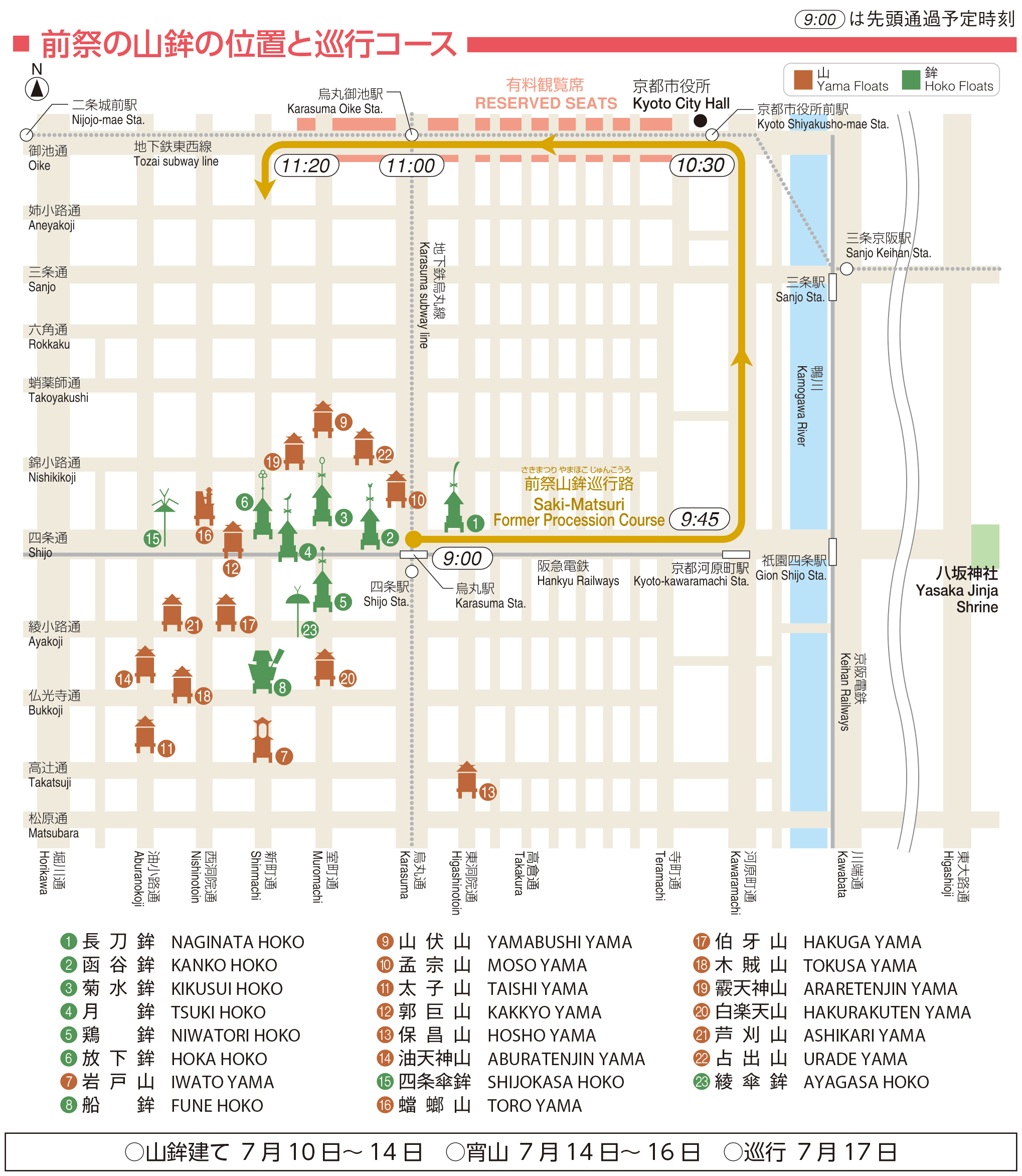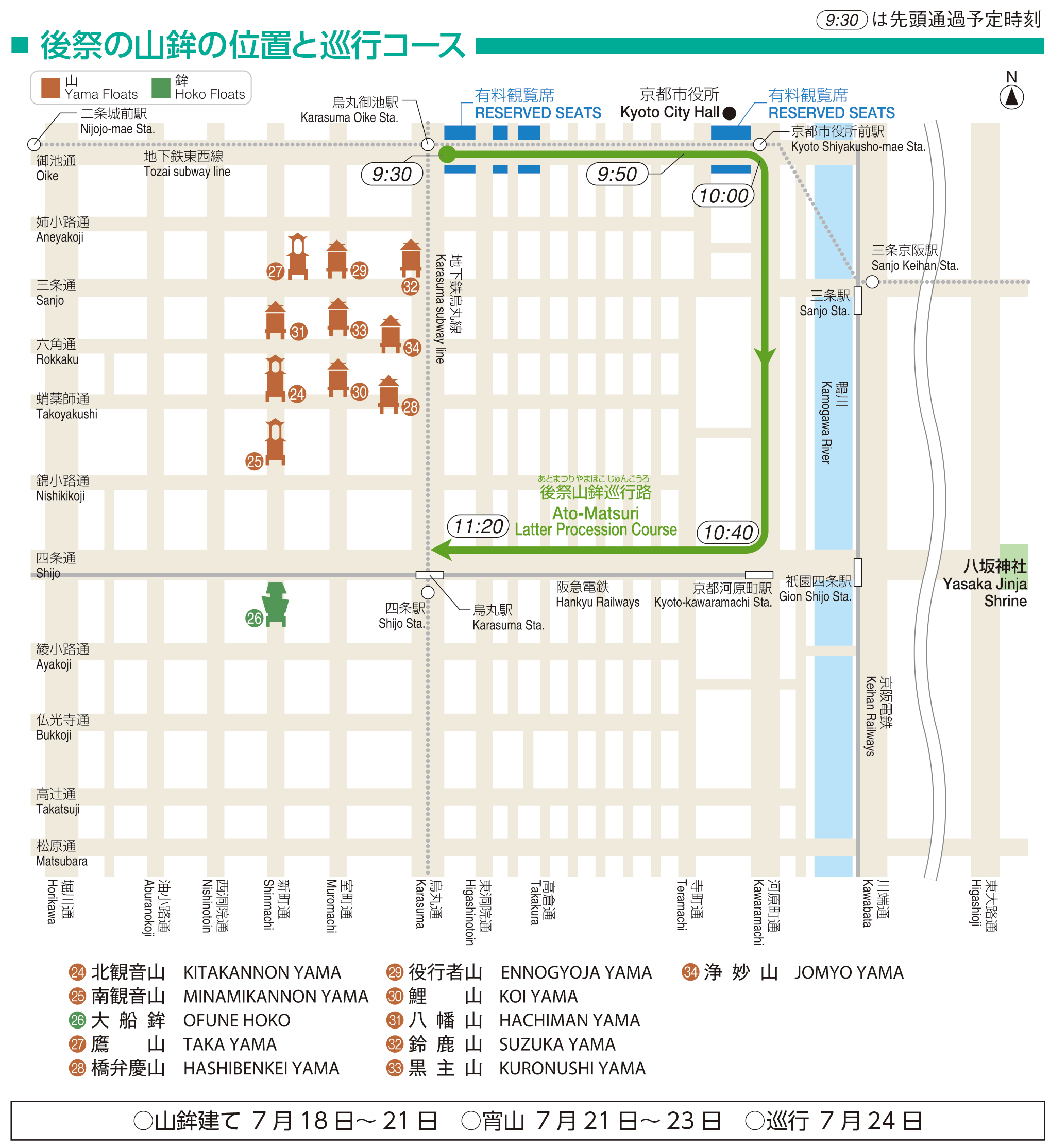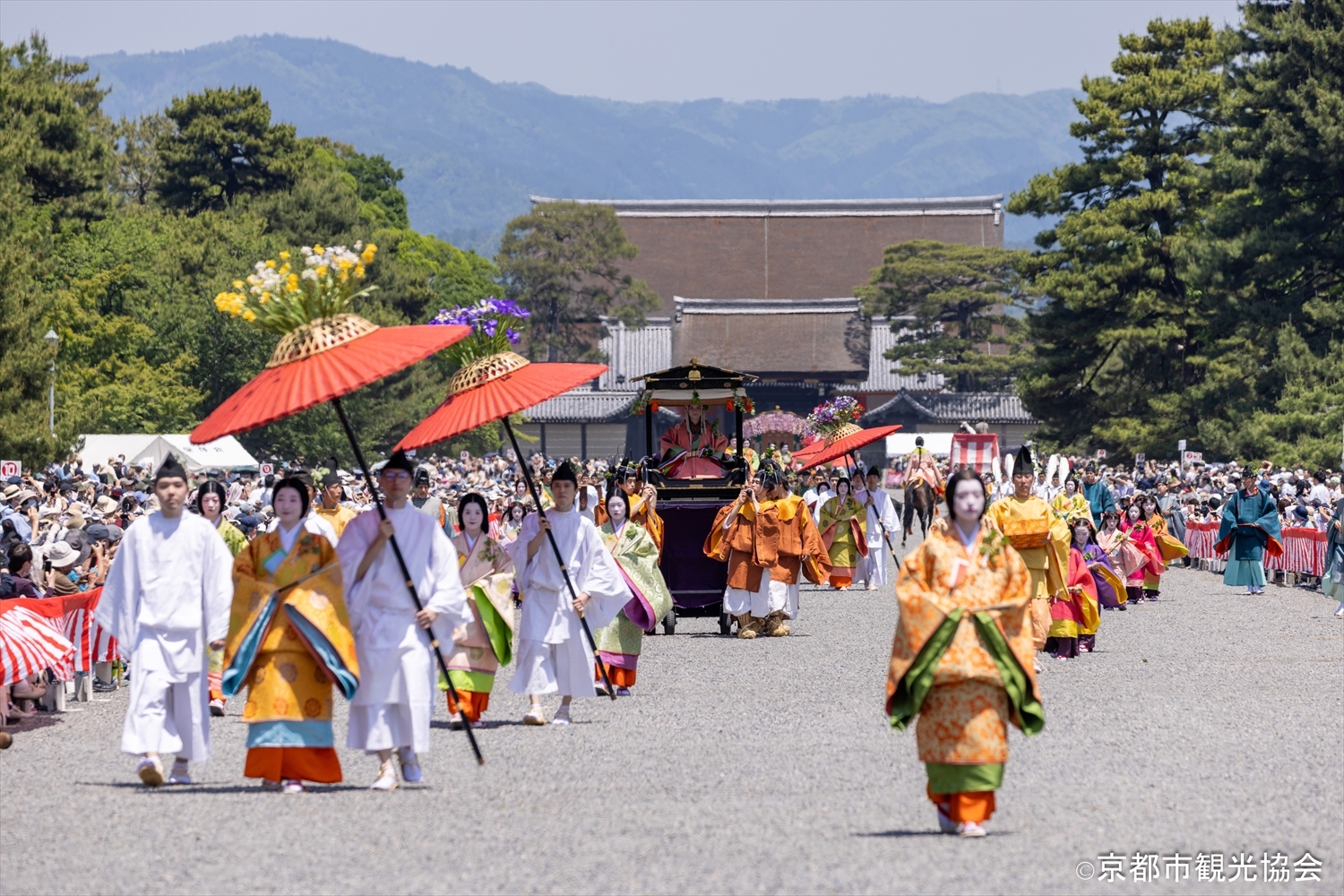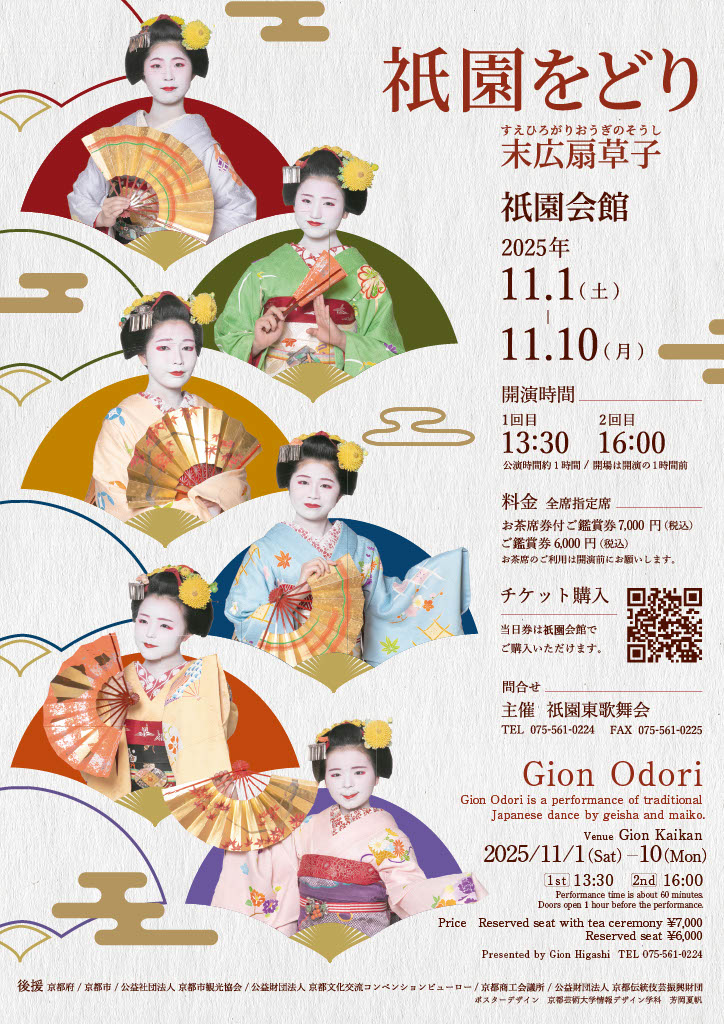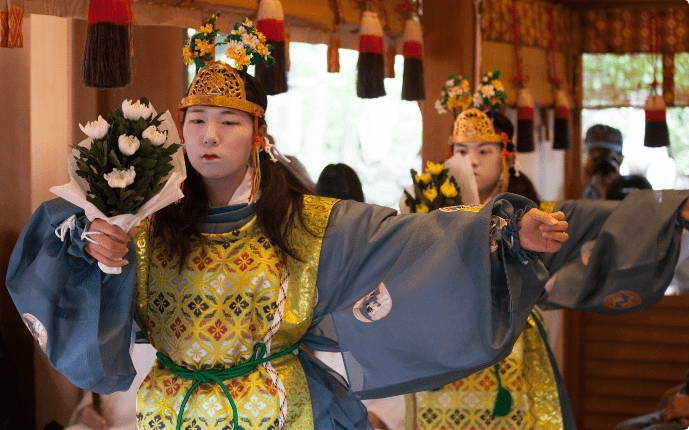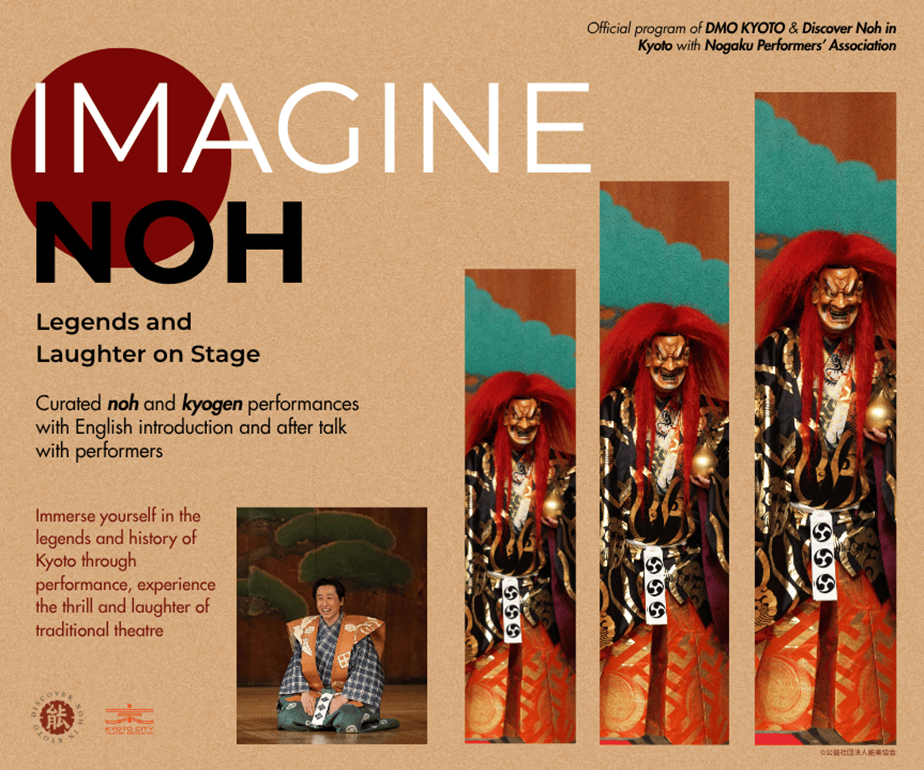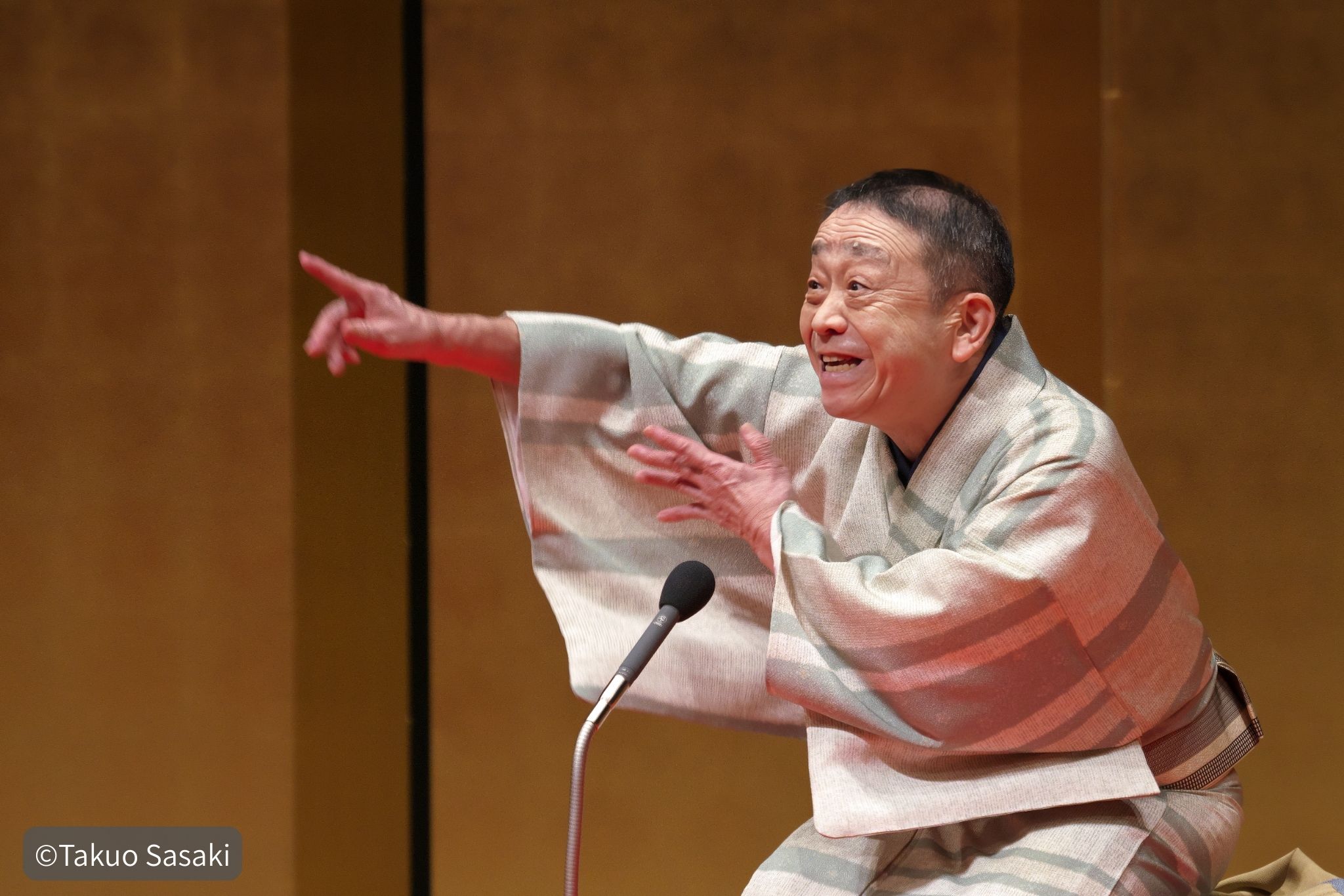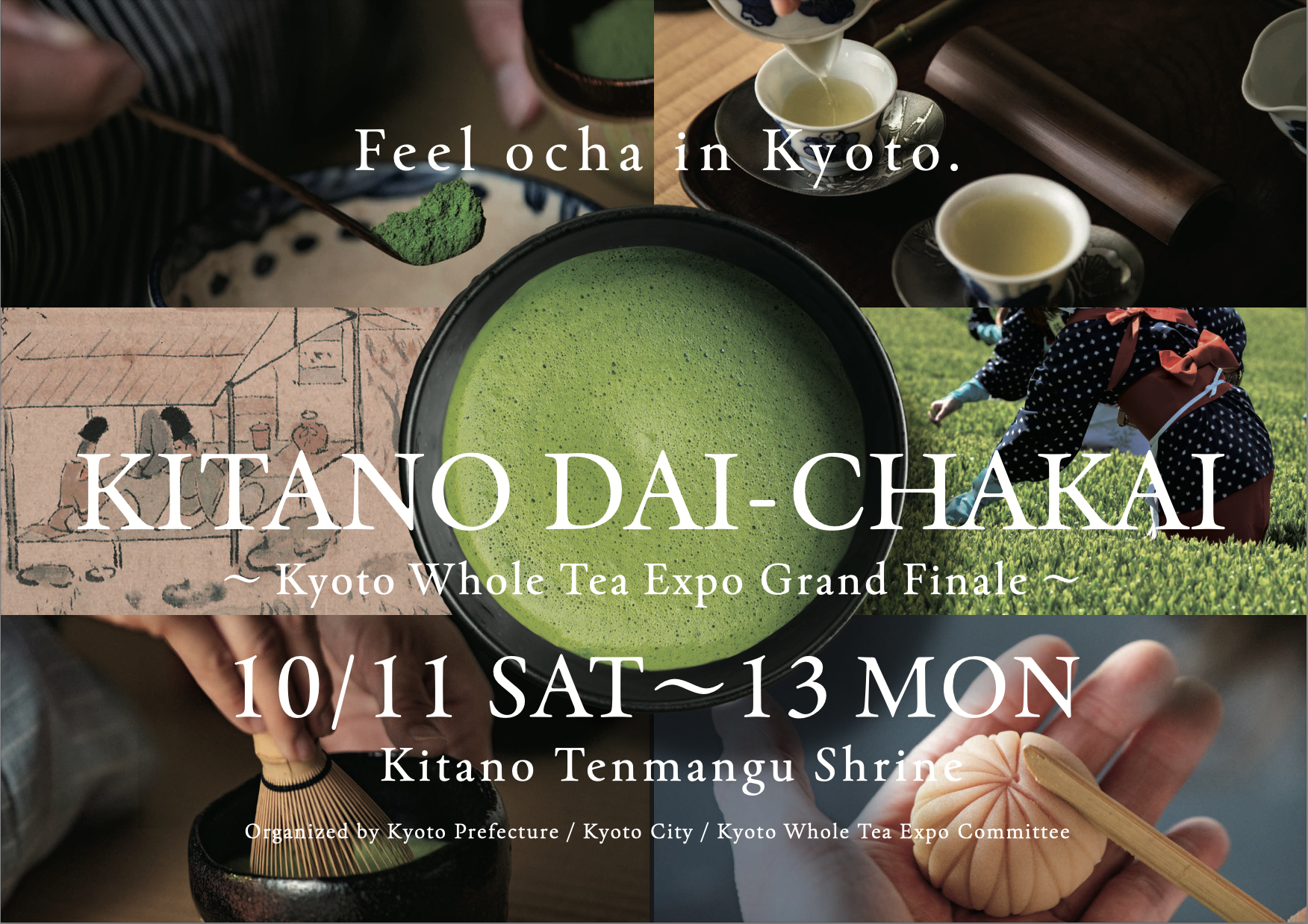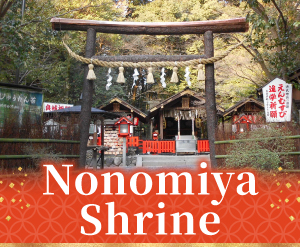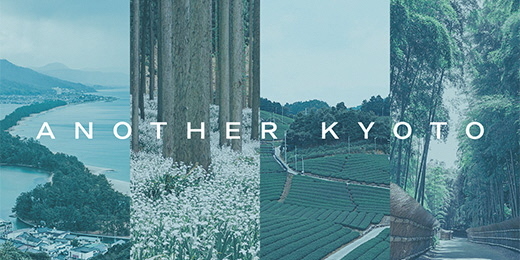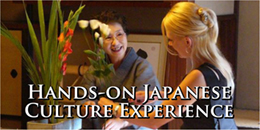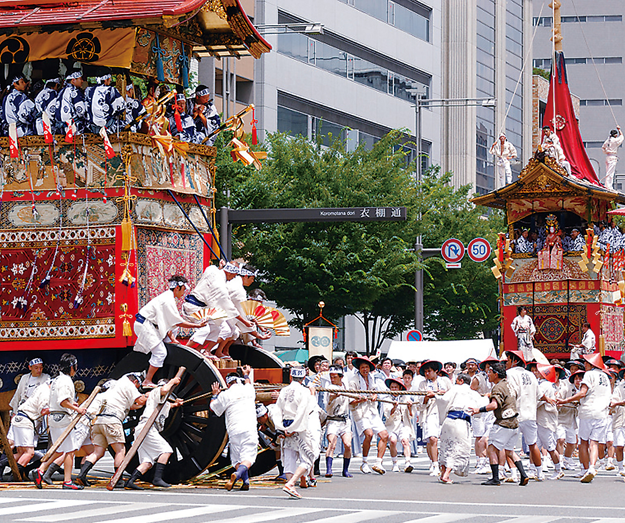
What is the Gion Matsuri Festival?
The Gion Matsuri in Kyoto is one of the three greatest festivals in Japan. The other two are the Kanda Matsuri in Tokyo and Tenjin Matsuri in Osaka. Among these the Gion Matsuri may be said to be the largest and most extravagant festival. It is held annually from July 1st to 31st as the midsummer celebration of Yasaka Jinja Shrine. The highlights of this celebration take place on the 17th (Early or Saki Matsuri Festival) and the 24th (Latter or Ato Matsuri Festival) when the processions of 34 floats in total are demonstrated along the main streets of the city. All of Kyoto is in a festive mood during this period. Houses along the route of procession usually openly display the many screens and other treasures of Japanese culture which have been handed down through generations. Hence, this event is also called Byobu Matsuri, the Screen Festival.
Origin
The origins of the Gion Festival, which is a religious observance of Yasaka Jinja Shrine, go back to the formation of the Gion Goryo-e, the Gion Ghost (evil spirit) Ritual. In 869, while Kyoto was still the capital of Japan, the whole country was stricken by a plague. The Emperor dispatched his special messenger to Yasaka Jinja Shrine to pray for the immediate end of the terrible disease. Yasaka Jinja Shrine erected sixty-six halberds representing the sixty-six provinces of the country and offered them as prayer to the god Gozu Tenno. This is said to be the origin of Gion Festival.
From the year 970 the Gion Goryo-e Ritual became an annual event. From that time through the end of the Heian Period (794-1185) the ritual started to transform into a festival for large numbers of people, and during the Muromachi Period (1336-1573) the Yama-Hoko floats which can be seen in the present-day Gion Festival began to appear. There was a time where the festivities were unable to be held however, such as in the latter part of the 15th century, due to the ongoing wars.
The spirit of the sea god in Japanese mythology – Susano-o was believed to be enshrined in Gion Shrine, the old name of Yasaka Jinja Shrine. His spirit was said to have transferred to several sacred carriages belonging to Yasaka Jinja Shrine. Since he was believed to have the unusual power to combat the plague, these sacred carriages were carried in the middle of Kyoto by young men of the city and of the neighboring farms.
In order to add splendor and beauty to the floats used in the procession many of the treasures and ornaments used to decorate them were imported from countries noted for their fine treasures such as: China, Persia, Korea, Holland and France.
This practice was started in the Edo period (from 17th century). The participants have always made efforts in order to improve the beauty of the floats and to provide more enjoyment for themselves and the observers.
Outline of the festivities
The Gion Matsuri continues practically throughout the month of July, and consists of various major and minor events. The most important ones are:
July 2
Kujitori-shiki
The lottery to determine the order of the floats in the procession is held at the City of Kyoto Council Chambers and presided over by the Mayor of Kyoto and the leaders of the Festival.
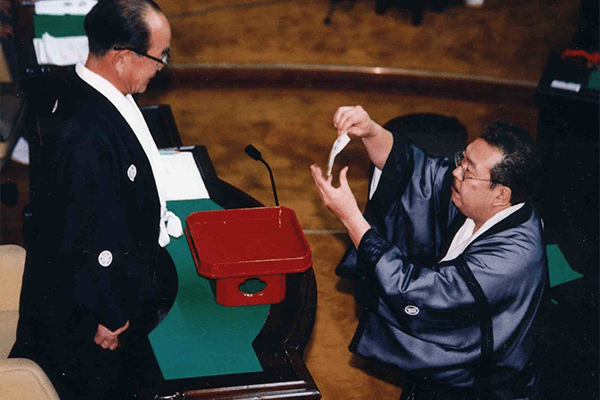
July 10
Omukae Chochin (The Lantern Procession)
The procession of shrine parishioners carrying festival lanterns hoisted on long bamboo poles, setting out to greet the portable shrines (mikoshi) on the evening of the Mikoshi Arai purification ritual.
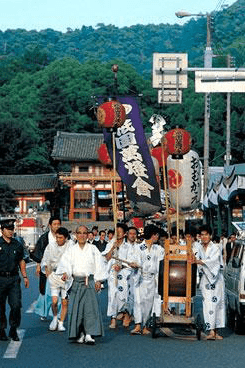
Mikoshi Arai (Ritual purification of one of the portable shrines)
Purification ritual carried out by the chief priest of the shrine on the evenings of July 10 and 28. Out of the three portable shrines (mikoshi) that participate in the festival, the shrine dedicated to the principal deity, also called Naka Goza, is taken away undecorated to the Kamo river at Shijo Bridge to be purified.
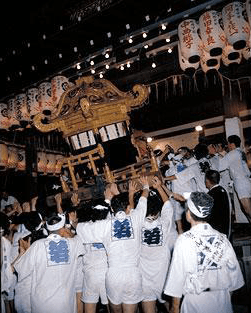
July 14~16
Early Festival Yoiyama Procession Eve
Procession eve is the time during the Gion Matsuri in which the flames are lit in the decorative komagata lantern of each Yama-Hoko and the Gion Music from the floats fills the air. The pedestrian roads and the floats themselves are gorgeously decorated with festival lanterns. Old houses in Yamahoko-cho remove the latticework from the fron and open their tatami rooms to the public, where they display their treasured folding screens and other decorations. It is held right before the Early Festival Yamahoko Junko.
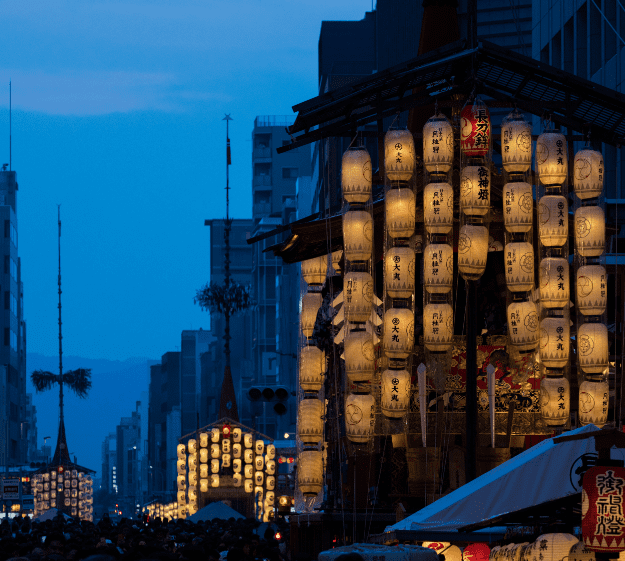
July 17
Early Festival Yamahoko Junko (Float Procession)
(From 9 AM)
The procession of 23 floats is demonstrated along Shijo, Kawaramachi, and Oike streets. Their beautiful decorations appear even more splendid under the bright summer sunlight.
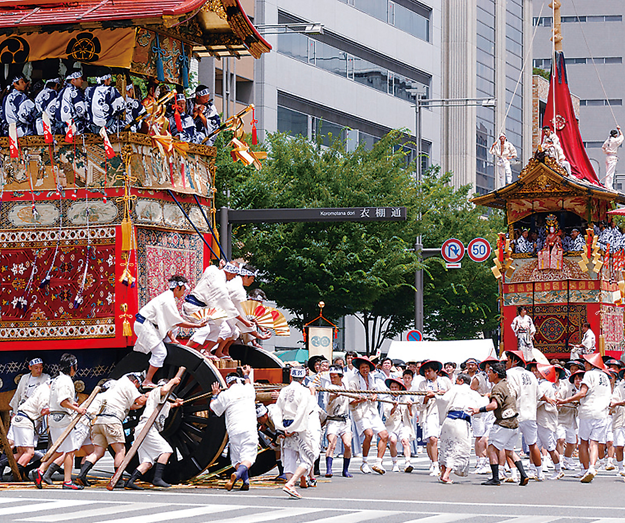
Shinko-Sai (Procession of the Sacred Carriages)
The three sacred carriages are carried from the shrine on the shoulders of men. The sacred carriages arrive shortly afterward at the Otabisho, their temporary abode located on Shijo street.
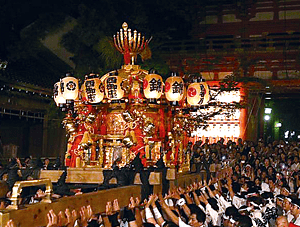
July 21~23
Latter Festival Yoiyama Procession Eve
Continuation of the Yoiyama Procession Eve, held right before the Latter Festival Yamahoko Junko.
July 24
Latter Festival Yamahoko Junko (Float Procession)
(From 9:30 AM)
The procession of 11 floats is demonstrated along Oike, Kawaramachi and Shijo streets.
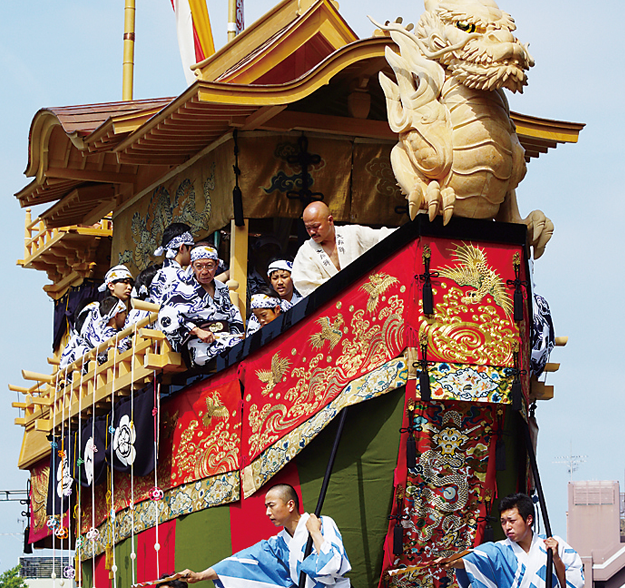
Hanagasa Junko (Procession of Flower Sunshade)
In the Hanagasa procession, ten or more Hanagasa-style floats, along with child performers mounted on horseback (uma-osa chigo), children dressed as warriors (komusha), and performers of traditional arts and dancers from the entertainment district form a parade line almost a thousand strong. They perform traditional arts and dances as a form of offering.
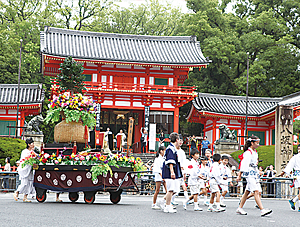
Kanko-Sai (Procession of the Sacred Carriage)
The three sacred carriages are carried from their temporary abode and finally return to their shrine.
July 28
Mikoshi Arai (Rite of Cleaning the Sacred Carriages)
The sacred carriages are taken from the Shrine to Shijo Ohashi Bridge and are cleaned according to time-honored custom, and then taken back to their Shrine around 8:00 PM.
July 31
Eki-jinja Nagoshi-sai: The Plague God Shrine Festival
(From 10:00 AM)
The last of the sacred ceremonies of the month-long Gion Matsuri. The Shinto gate of the Plague God’s Shrine, dedicated to the worship of Somin Shorai is bedecked with a large wreath made of thatch. At 10 AM, rice cakes are offered to gods and all of the assembled worshippers pass through the wreath together, giving thanks, banishing evil and praying for protection from sickness and accidents.
The location and course of Yamahoko Junko during Saki Matsuri (Early Procession; July 17th)
The location and course of Yamahoko-Junko during Ato Matsuri (Latter Procession; July 24th)
We have made a Guide for Gion Matsuri Yoiyama and Procession
In order to help you fully enjoy Gion Matsuri we have made digital maps (accessible via GPS as well) for Saki Matsuri and Ato Matsuri. During Yoiyama period (July 21st ~ 23rd), we will distribute them in the following URL. You will also be able to download the maps as PDF data. Please have a look and come to Gion Matsuri.
Digital Map (Saki Matsuri, Ato Matsuri)
PDF Data

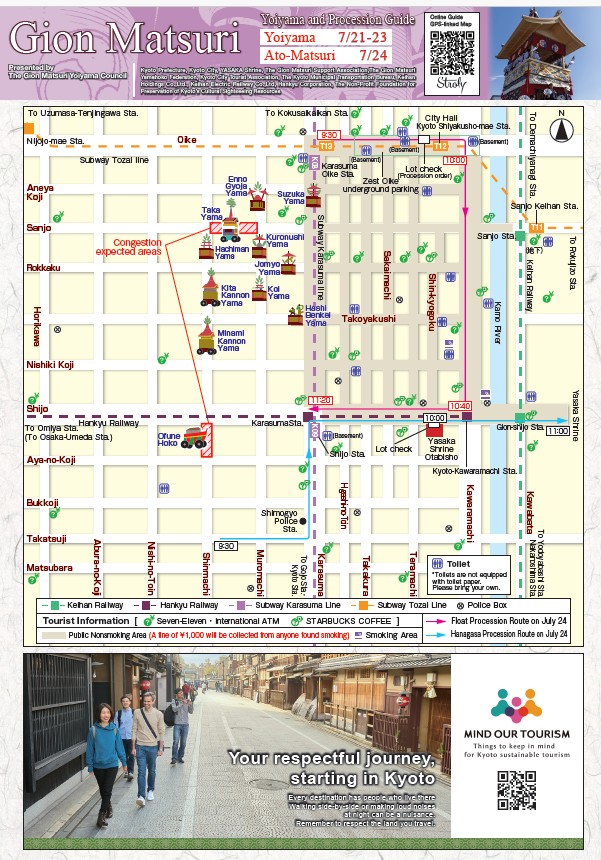
The floats and their symbolism
The origin of the designs and themes of the Yama Hoko floats can be found in either ancient Japanese or Chinese legends or folktales; with the exception of the Naginata Hoko float, which originates in the Goryo-e ghost rituals, and the Kasa Hoko – decorated umbrella floats, created from the belief that umbrella canopies represent the divine spirit. There are also floats such as Ashikari Yama, Tokusa Yama, Kuronushi Yama, etc. whose design are based on songs from Noh plays.
Float structure
Hoko and Hikiyama
A Hoko has a sacred pole that represents the divine spirit. It has wheels that are 2 meters in diameter and is moved by pulling a large, long rope. About 40 to 50 musical accompanists ride on the float during the procession. Hikiyama is build in the same way as a Hoko, but it also includes a pine pole with leaves on top that represent the divine spirit.

Kakiyama
People carry this kind of float on their shoulders for the procession. They commonly have sacred pine poles with pine leaves on top. There are exceptions however, as Taishi Yama has a cedar pole, and Toro Yama, Hashibenkei Yama and Joumyo Yama do not have sacred poles.
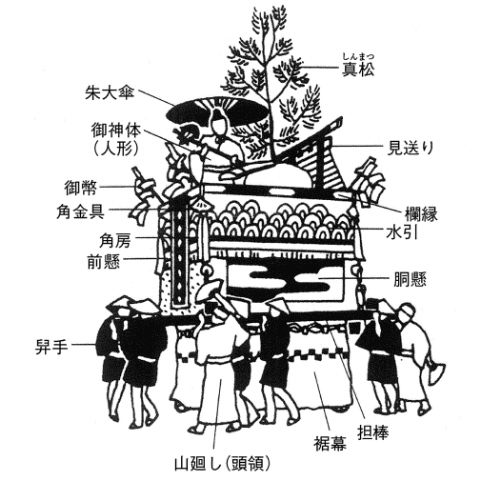
Funagata
Built in the shape of the ship, this float does not have a sacred pole unlike other Hoko. It has wheels and is moved by being pulled with a rope. About 40 to 50 musical accompanists ride on the float for the procession.
Kasahoko
This float uses a sacred umbrella instead of a sacred pole. People with bells, drums and flutes dance alongside the float during the procession.
The floats of the Saki Matsuri (Early Festival) - July 17th
Naginata Hoko
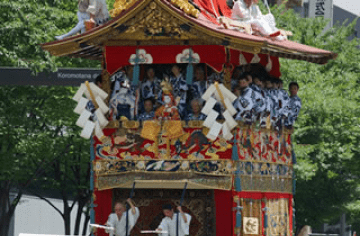
This float takes its name from the long pole and large blade (naginata) attached to the roof. Naginata Hoko always leads the procession. It is the only one that includes a real child riding atop it as its sacred symbol (chigo).
Kanko Hoko
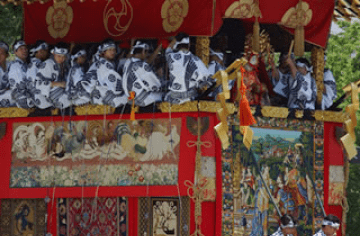
The name of this float comes from an ancient story about a famous Chinese politician from the 3rd century BCE, Moshokun. A crescent moon and mountain found on the roof represent the darkness of the mountains when Moshokun, pressed for time to reach the battlefield, mimicked a rooster’s cry so that the mountain gate would be opened even though it was not yet dawn.
Kikusui Hoko
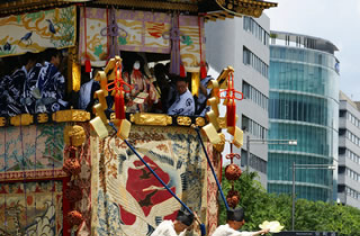
The name of this float comes from the neihborhood well called the Kikusui Well. A shiny gold chrysanthemum flower carving adorns the roof, while the legendary hermit, Hoso is its sacred symbol.
Tsuki Hoko
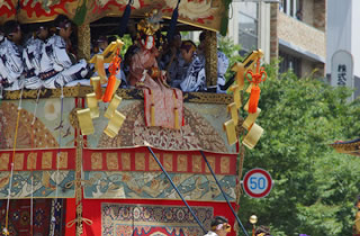
The name of this float comes from the crescent moon (tsuki) symbol that can be found atop it. There is a small figure of Tsukiyomi (the Moon deity) in the middle of the sacred pole atop the float. The body of the float is decorated with beautiful carpets from India and Turkey.
Niwatori Hoko
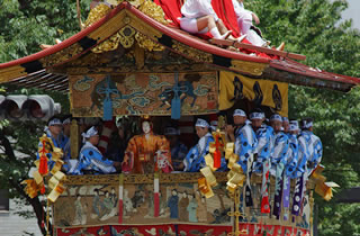
This float was made in inspiration of an acient Chinese legend. It said that a large drum was beaten during legal disputes but that it was left unused for many years as the country enjoyed longterm peace. During this time moss grew on the drum and a hen took up residence within it. It is thus a symbol of peace. The sign atop the float represents the egg in the drum.
Hoka Hoko
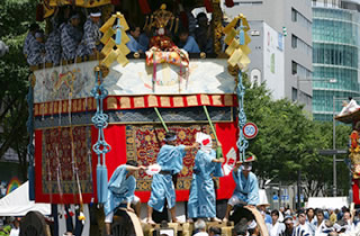
This float’s name originates from the figure of the Buddhist monk named Hoka enshrined in the middle of the sacred pole. The symbol at the hoko float top represents rays from the sun, moon and stars that light the world. The body of the float is decorated with carpets from India and Persia, bearing delicate flowers patterns.
Iwato Yama
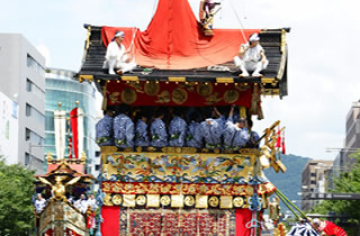
This float incorporates two themes into its design; the myth of god Izanagi-no-Mikoto creating the world with the Ame-no-nuhoko spear in his hand and the myth of the sun goddess Amaterasu emerging from the Ama-no-Iwato cave. Unlike other yama floats, this one is pulled along with the use of its wheels, instead of being carried on the shoulders of the festival’s participants. Since this float does not have a place to set the sacred pine tree, it is attached directly to the roof.
Fune Hoko
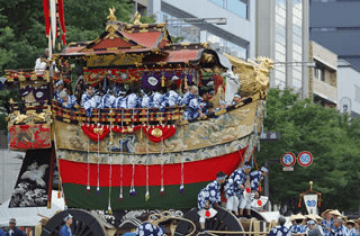
Based on a legend about Empress Jingu (169-269 CE), the float bears the figure of a ship. The golden figure of an fantastical bird is attached to the front of the ship, while the helm depicts traditional flying dragon patterns. There is a figure of the empress, as well as three deities; Isora, Sumiyoshi and Kashima enshrined on the float.
Yamabushi Yama
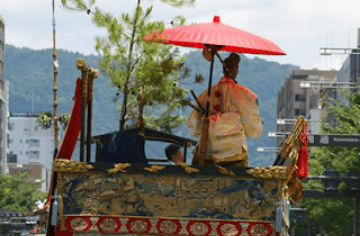
The deity enshrined on this float represents a Buddhist monk who is said to have corrected the leaning Yasaka Pagoda with his mysterious power. The figure represents the time when he was about to enter Mount Omine for his harsh Buddhist training.
Moso Yama
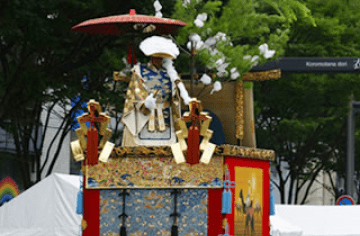
This float is also known as the Takenoko (Bamboo Shoot) Yama. It depicts the scene from an ancient Chinese legend where the famous scholar, Moso (3rd century), was able to find bamboo shoots under the ground, which he wished to present to his sick mother.
Taishi Yama
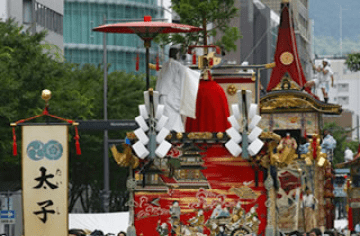
When the imperial prince Shotoku (574-622 CE) commissioned the construction of Shitenno-ji Temple in Osaka, he went into the mountains and collected material for its construction by himself. Inspired by this story, this float is the only one in the whole procession made out of cedar, not pine.
Kakkyo Yama
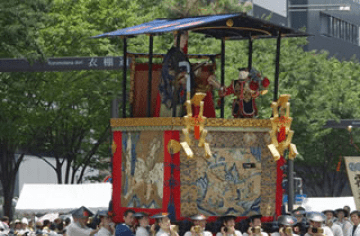
This float is based on an ancient Chinese story about a man called Kakkyo. He was very poor and could not afford to feed his whole family. Deciding to abandon his child one day he starts to dig a hole to bury him in. While digging it however, he discovers a pile of gold that lets him and his family live happily afterwards.
Hosho Yama

This float is based on a romance between a court nobleman, Yasumasa Hirai (11th century) and a female court servant, Izumi Shikibu. The figure on the float represents the scene where Yamasa breaks a branch off of a plum tree from one of the imperial palace buildings to present to Shikibu. Based on their story, a charm (talisman) for good luck in matchmaking is sold during the time of the Yoiyama festival.
Aburatenjin Yama
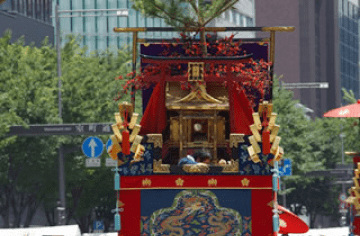
This float carries the deity worshipped in the local community for many generations. The name of the floats comes from the street the shrine is located on: Aburanokoji.
Shijokasa Hoko
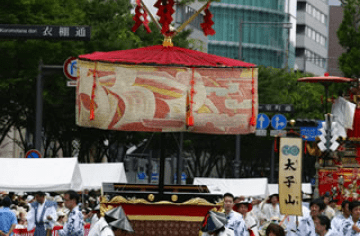
This float takes the form of a large, traditional umbrella, opulently decorated with sacred paper pieces and a pine tree on top. Its origins date back to the 15th century, though it was restored in 1985.
Toro Yama

This float was made as a tribute to the samurai named Takasuke Shijo, who fought against the Ashikaga army and died in the war during the period of political divide in 14th century Japan. His courage was associated with an ancient Chinese story of a brave mantis. Hence, this float has a large mantis puppet placed on top of it.
Hakuga Yama
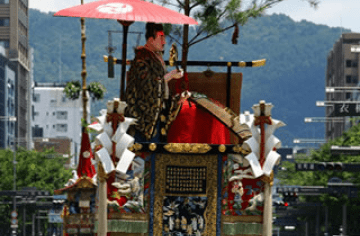
This float is based on the story of a Chinese harp player, Hakuga and his friend, set in the Zhou dynasty (3rd-11th century BCE). When Hakuga’s friend passed away, he was so devastated that he decided to never play the harp again. The figure placed on top of the float depicts the scene in which Hakuga readies himself to destroy his instrument with an axe in his hands.
Tokusa Yama
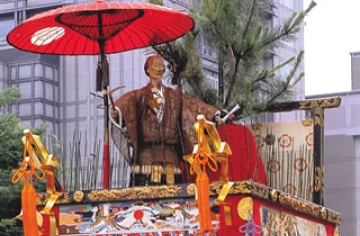
This float was made in inspiration of an old Japanese song called “Tokusa”. The figure placed on top of it represents the character of a man who appears in it. The man leads a lonely life, cutting rushes in the area of Shinano (present-day Nagano prefecture) after his son is kidnapped.
Araretenjin Yama

In the early 16th century the city of Kyoto was almost completely burned to the ground in a fire. However, a non-seasonal hail (sometimes called arare in Japanese) suddenly fell on the city and put out the fire. A small figure of Buddha was discovered in the hail and the people enshrined it as an important guardian of the community. It is worshipped as the deity of this float.
Hakurakuten Yama
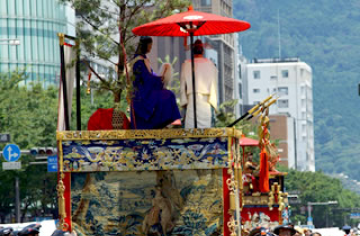
The figures on this float depict a scene in which a Chinese poet, Bai Juyi (772-846) is asking the Zen Buddhist monk, Dorin (741-824) a question about Buddhist philosophy. Dorin sits underneath a pine tree holding a Buddhist rosary and a horsehair flapper in his hands while Bai Juyi stands wearing a formal Chinese hat and holding a scepter.
Ashikari Yama
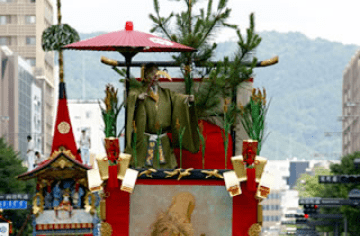
This float is based on the classical Japanese song called “Ashikari”. It tells the story of an old man living alone by the sea cutting rushes, after being separated from his wife. The couple was able to reunite however, and thus this float represents the harmonious relationship of a married couple after a long period of separation.
Urade Yama
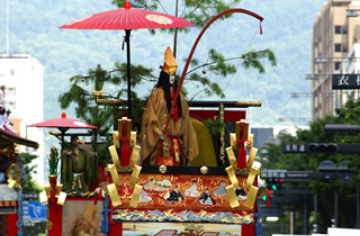
This float is based on the story of Empress Jingu (169-269 A.D.) who tried to foresee whether her troops would win in the coming battle. She caught a sweetfish, signaling their imminent victory. The figure placed upon the float represents this moment, wearing a long golden hat, with a fishing pole in her right hand and the captured fish in her left.
Ayagasa Hoko
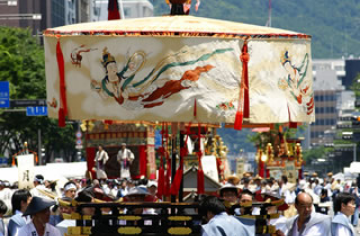
This is one of the oldest Yamahoko floats. It is characterized by its large vermillion umbrella being carried by people accompanied by musicians playing gongs, drums and flutes while dancing in long red wigs. Six young boys – Chigo – walk in front of the float.
The floats of the Ato Matsuri (Latter Festival) - July 24th
Kitakannon Yama
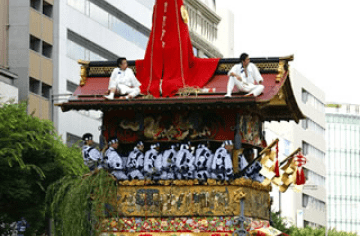
This pull-style float carries two deities: Yoryu Kannon and Idaten. It is decorated with willow branches for the procession. There are two patterns of tapestry, called Kannon Karakusa and Unryu, that are used alternatively depending on each year.
Minamikannon Yama
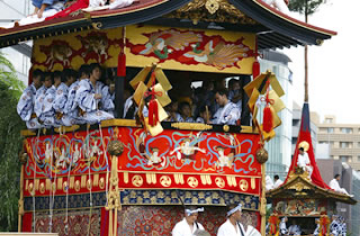
The deity enshrined in this float is the statue of a Buddhist monk from the Kamakura period (1185-1333) sitting in meditation. There are large willow branches set on the float and wooden medicinal balls on the four corners, which are believed to ward off illnesses.
Ofune Hoko

The Fune Hoko float that appears in the Saki Matsuri (Early Festival) Procession is regarded as a ship going into battle, while the Ofune Hoko from the Ato Matsuri (Latter Festival) Procession is the ship returning from the battle. The float was lost and no longer appeared in the 19th century, but it was successfully revived in 2014, thanks to the great efforts and support of the local community.
Hashibenkei Yama
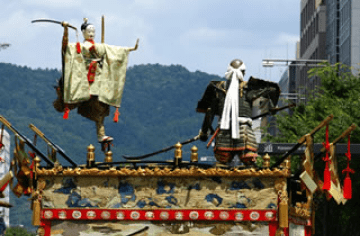
The figures on this float represent two famous historical figures in Japanese history: the Buddhist warrior monk Benkei and his master – Ushiwakamaru. The float depicts the scene of a battle between Benkei (wearing armor with a large sword in hand) and Ushiwakamaru (wearing robes and a sword in his right hand) on the Gojo Bridge.
Ennogyoja Yama
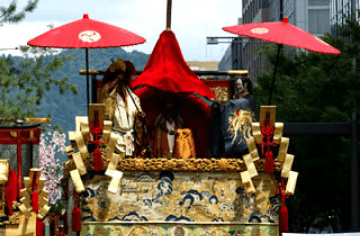
Three deities are enshrined on this float: Ennogyoja (Buddhist monk; 634-701), Hitokotonushi and Katsuragi (Japanese gods). This float was created based around the legend of Ennogyoja manipulating Hitokotonushi with his mysterious power in order to build a bridge between the mountains of Katsuragi and Omine.
Koi Yama
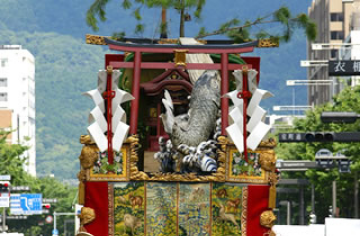
An ancient Chinese legend says that a carp can transform into a dragon if it succeeds in reaching the top of a steep and dangerous waterfall. This float depicts this legend, showcasing the figure of the brave carp. There is also a vermilion lacquered shrine hall placed upon the float, where the sea deity, Susano-o is enshrined.
Hachiman Yama
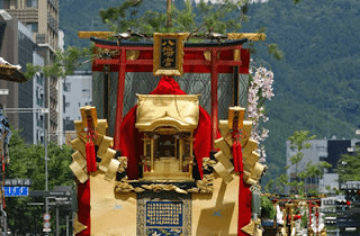
The deity of the local shrine – Hachiman-gu Shrine is transfered on top of this float during the festival period. The deity is enshrined and looked after in the local community hall for the rest of the year. The shrine hall attached to the float shines in the sunlight, as it is entirely coated in real gold leaves.
Suzuka Yama
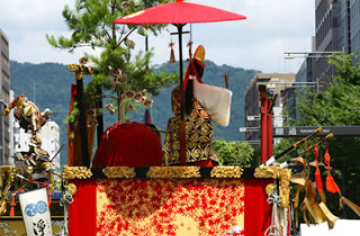
The figure on this float depicts the legendary female character – Suzuka Gongen (also known as Suzuka Gozen), who defeated an evil ogre that was causing suffering to the local people of Ise province (present-day Mie Prefecture) on Suzuka Mountain. The figure wears a tall gold hat and holds a large sword in her hand.
Kuronushi Yama
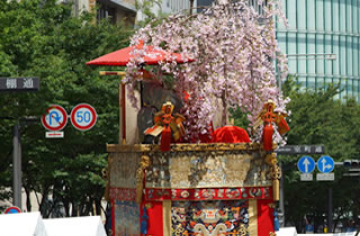
Based on a classical Japanese song “Shiga”, the figure placed upon this float depicts the Heian Period (794-1192) poet – Kuronushi Otomo, as he admires a large cherry tree in full bloom. It is believed that hanging cherry blossom decorations from this float can keep away misfortune when placed at the house entrance.
Jomyo Yama
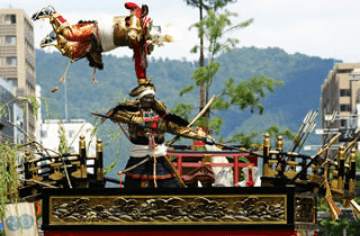
This float is based on a passage from the Heike Monogatari (The Tale of the Heike) in which the Buddhist soldier, Jomyo, tried to reach the battlefield via the Uji River, while another, called Ichirai, jumped over him and arrived first.
Taka Yama
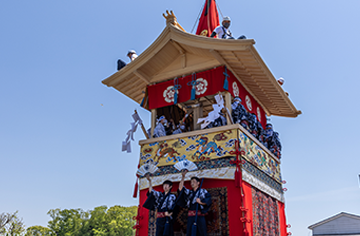
Taka Yama is one of the floats which date back to the time of pre-Onin War in the 1460s. This float enshrines the images of a falconer, a master of hounds, and a servant carrying a cask on his back. Taka Yama stopped being a part of the Yama-Hoko Procession in 1826. In 2019 however, it resumed its participation, now only carrying a karabitsu – a sacred chest with a hanging scroll that has the name of a deity of Yasaka Shrine written on it. In 2022 Taka Yama has been able to return to the procession fully decorated for the first time in 196 years.
Gion Matsuri Festival Saki Matsuri (Early Procession) and Ato Matsuri (Latter Procession) – Revival after half a century
In traditional Japanese festivals, the deity is carried from one shrine to a special place during the festival, and then, returned to their original place as the festival ends. Therefore, organizing two rituals is very important: one to welcome the deity and another to return them to their original place.
Generally, mikoshi portable shrines play important roles in both rituals to carry the spirit of the deity. The mikoshi are carried on people’s shoulders and paraded around the neighborhood. Then, they are temporarily placed in a special place called Otabisho until the deity is returned to the original shrine. The ritual to carry the deity out is called the Shinko-sai Festival while the one that returns the deity is called the Kanko-sai Festival.
In the Gion Matsuri Festival, the Shinko-sai Festival is held on the 17th and the Kanko-sai Festival is on the 24th of July. Opulently decorated floats were considered to be preliminary celebration before the important mikoshi processions. The float procession prior to the Shinko-sai Festival is called Saki Matsuri (the Early Procession) and the procession prior to the Kanko-sai Festival is called Ato Matsuri (the Latter Procession). Hence, the original Gion Matsuri Festival used to have two float processions. The Saki Matsuri and the Ato Matsuri had different procession routes. The Saki Matsuri went on Shijo Street from the west to the east, turned to the south on Teramachi Street, and then, turned to the west at Matsubara Street. The Ato Matsuri went on Sanjo Street from the west to the east, turned to the south on Teramachi Street, and then, turned to the west at Shijo Street. During Japan’s high economical growth period, the procession routes had to be changed due to increasing car traffic on the roads. In 1966, the Saki Matsuri and Ato Matsuri were merged and only one procession took place on July 17th until 2013.
However, since 2014, the Gion Matsuri Festival has returned to its original form. In order to succeed the tradition of the festival faithfully, processions started to be held twice. Finally, the original form of the festival that has existed for over 1000 years returned to the present-day.
Information about Gion Matsuri Festival Procession’s Paid Viewing Seat Tickets
Related articles
Note
Remember that the Gion Matsuri is organized in a residential area where the locals go about their daily life. Please do not forget to respect them and stay considerate of the local community.
Kyoto City has created a code of conduct called “Kyoto Guidelines” that summarizes what tourists, business operators, and citizens should do to show respect to one another and build a sustainable Kyoto.

